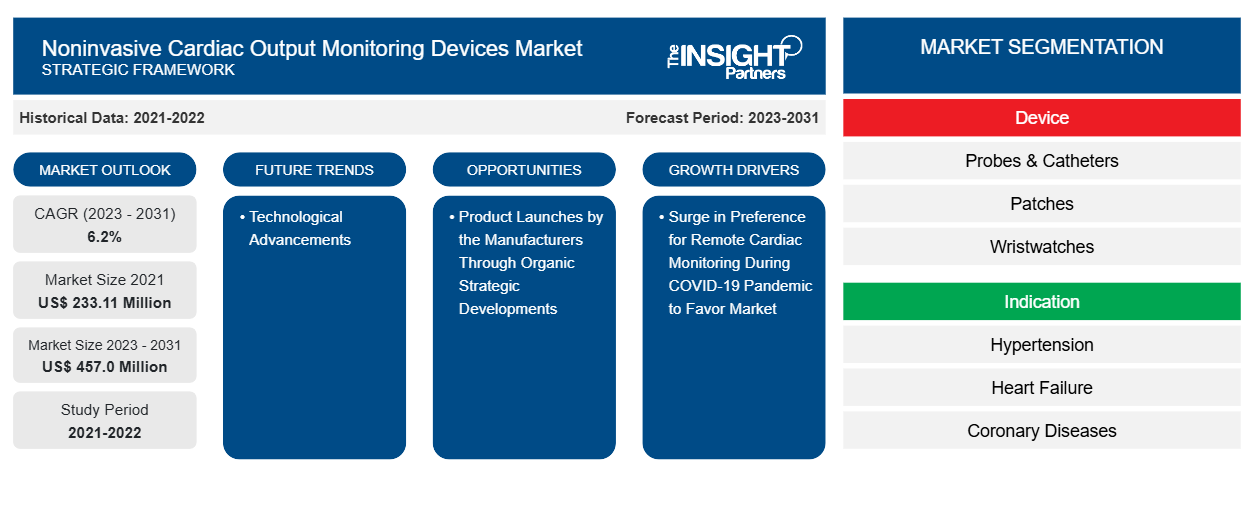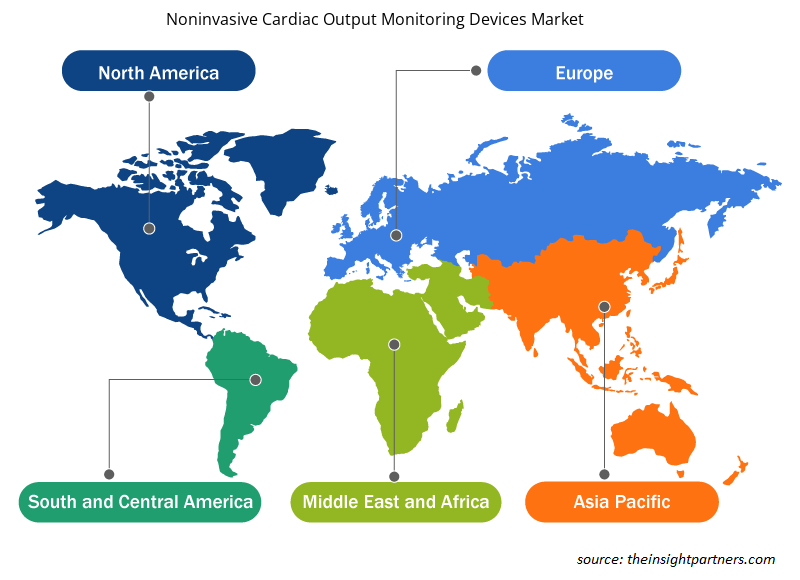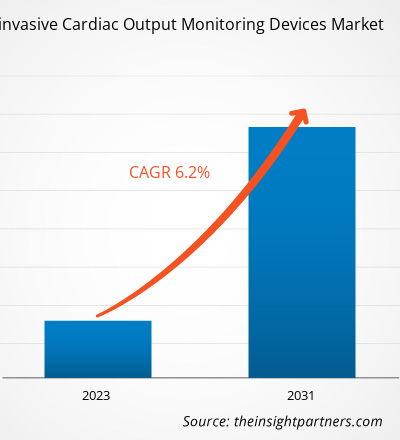Il mercato dei dispositivi di monitoraggio non invasivo della gittata cardiaca è stato valutato a 233,11 milioni di dollari USA nel 2021 e si prevede che raggiungerà i 457,0 milioni di dollari USA entro il 2031. Si prevede che il mercato registrerà un CAGR del 6,2% dal 2023 al 2031. È probabile che i progressi tecnologici rimangano tendenze chiave nel mercato dei dispositivi di monitoraggio non invasivo della gittata cardiaca.
Dispositivi di monitoraggio non invasivo della gittata cardiacaAnalisi complessiva del mercato
La misurazione della gittata cardiaca (CO) è essenziale nelle pratiche mediche. In passato, il monitoraggio cardiaco invasivo era il trattamento gold standard per la diagnostica. Tuttavia, negli ultimi anni, diversi dispositivi di monitoraggio della gittata cardiaca non invasivi sono stati sviluppati dai principali produttori di dispositivi medici. Questi dispositivi sono prodotti tecnologicamente avanzati che offrono soluzioni alternative alle popolazioni cardiache riluttanti a sottoporsi a trattamento diagnostico cardiaco invasivo.
Dispositivi di monitoraggio non invasivo della gittata cardiacaPanoramica del mercato
Tecnologia, innovazione e soluzioni tecnologiche intelligenti continuano a influenzare positivamente la crescita del mercato dei dispositivi di monitoraggio della gittata cardiaca non invasiva in modo significativo. Il progresso tecnologico è una tendenza chiave per la crescita del mercato. I lanci di nuovi prodotti da parte dei produttori tramite sviluppi strategici organici forniranno opportunità redditizie per la crescita del mercato dei dispositivi di monitoraggio della gittata cardiaca non invasiva durante il periodo di previsione.
Personalizza questo report in base alle tue esigenze
Riceverai la personalizzazione gratuita di qualsiasi report, comprese parti di questo report, o analisi a livello nazionale, pacchetto dati Excel, oltre a usufruire di grandi offerte e sconti per start-up e università
Mercato dei dispositivi di monitoraggio non invasivo della gittata cardiaca: approfondimenti strategici

- Scopri le principali tendenze di mercato in questo rapporto.Questo campione GRATUITO includerà analisi di dati che spaziano dalle tendenze di mercato alle stime e alle previsioni.
Dispositivi di monitoraggio non invasivo della gittata cardiacaFattori di mercato e opportunità
Aumento della preferenza per il monitoraggio cardiaco remoto durante la pandemia di COVID-19
per favorire il mercato
Le tecnologie di monitoraggio cardiaco remoto dei pazienti aiutano a rimodellare la gestione dei disturbi cardiaci rendendo l'assistenza sanitaria efficiente e accessibile. Ad esempio, le tecnologie di nuova generazione come i defibrillatori e i pacemaker gestiti da remoto spingono la domanda di assistenza cardiaca remota. Il monitoraggio cardiaco remoto sta avanzando con un'efficiente gestione dei dati dei dispositivi, con conseguente adozione di dispositivi avanzati di monitoraggio cardiaco non invasivo. Inoltre, c'è stato il supporto del governo per monitorare i segni vitali da remoto durante la pandemia di COVID-19. Ad esempio, a marzo 2020, l'USFDA ha annunciato l'autorizzazione all'uso esteso di dispositivi per monitorare i segni vitali dei pazienti da remoto. Consentire l'uso di dispositivi cardiaci remoti da remoto può aiutare gli operatori sanitari ad accedere alle informazioni sui segni vitali dei pazienti mentre il paziente è a casa, riducendo la necessità di visite ospedaliere e riducendo al minimo il rischio di esposizione al nuovo coronavirus. Inoltre, i principali produttori di dispositivi medici hanno lanciato innovativi dispositivi di monitoraggio della gittata cardiaca non invasivi durante la pandemia di COVID-19. Ad esempio, a maggio 2020, Octagos Health, una startup sanitaria con sede a Houston, ha annunciato il lancio di una piattaforma software di monitoraggio remoto di nuova generazione per pazienti con dispositivi cardiaci impiantati. Il software Octagon consente ai professionisti sanitari di accedere a pazienti cardiaci, pacemaker e defibrillatori tramite un unico portale. Inoltre, il software semplifica la gestione delle trasmissioni remote e fornisce contemporaneamente informazioni e analisi in tempo reale sui pazienti in una piattaforma sicura e basata sul cloud. Pertanto, l'approccio dei dispositivi di monitoraggio cardiaco remoto contribuirà in modo significativo alla crescita del mercato dei dispositivi di monitoraggio della gittata cardiaca non invasiva.USFDA announced the allowance of expanded use of devices to monitor patients' vital signs remotely. Allowing remote cardiac devices to be used remotely can help healthcare providers access information about patients’ vital signs while the patient is at home, reducing the need for hospital visits and minimizing the risk of novel coronavirus exposure. Furthermore, key Octagos Health, a Houston-based healthcare startup company, announced the launch of a next-generation remote monitoring software platform for patients with implanted cardiac devices. The Octagon software allows healthcare professionals access to cardiac patients, pacemakers, and defibrillators using one portal. Also, the software simplifies the management of remote transmissions and simultaneously provides real-time patient insights and analytics in a secure and cloud-based platform. Therefore, the remote cardiac monitoring devices approach will contribute significantly to the noninvasive cardiac output monitoring devicesmarket growth.
Progressi tecnologici
I progressi tecnologici hanno incoraggiato i produttori di dispositivi medici a progettare prodotti innovativi. Le tecnologie emergenti forniscono alternative efficaci al monitoraggio cardiaco tradizionale, creando avvisi per i pazienti a rischio di malattie cardiovascolari. Il Mobile Cardiac Telemetry (MCT) è un esempio di un dispositivo di monitoraggio cardiaco tecnologicamente avanzato. Il sistema MCT aiuta a monitorare le condizioni cardiache dei pazienti cardiaci. I pazienti portano con sé un piccolo sensore e un monitor per tutto il giorno. Ogni volta che si verifica un evento cardiaco, il MCT invia i dati a un sistema centrale per l'analisi e la risposta. Il sistema genera un report contenente grafici e tendenze e lo condivide con i medici del paziente per ulteriori azioni. I sistemi MCT possono analizzare ogni battito cardiaco e rilevare irregolarità nelle normali condizioni di un paziente, seguite dall'avvio di una risposta di emergenza immediata, il che li rende una delle opzioni più preferite per il monitoraggio cardiaco. Pertanto, l'adozione di tali dispositivi di monitoraggio della gittata cardiaca non invasivi tecnologicamente avanzati soddisfa le esigenze sanitarie di un paziente, il che guida la crescita del mercato dei dispositivi di monitoraggio della gittata cardiaca non invasivi.
Lancio di prodotti da parte dei produttori attraverso sviluppi strategici organici
I produttori stanno investendo nella progettazione di innovativi dispositivi di monitoraggio non invasivo della gittata cardiaca per collegare meglio gli ospedali ai pazienti cardiaci. Di seguito sono riportati alcuni sviluppi dei produttori.
- A giugno 2021, Max Healthcare ha lanciato un framework di monitoraggio dei pazienti integrato con un dispositivo basato sull'intelligenza artificiale (AI), che si dice sia il primo nel paese. Max Healthcare è uno dei maggiori fornitori di assistenza sanitaria in India, con oltre 15 ospedali superspecialistici, servizi diagnostici e di assistenza domiciliare integrata. Ha lanciato il servizio di monitoraggio dei pazienti basato sull'AI in collaborazione con un fornitore di soluzioni per la salute digitale denominato MyHealthcare. L'ecosistema Max MyHealth+, integrato in collaborazione con MyHealthcare, ha integrato misuratori della pressione sanguigna, dispositivi ECG e per la frequenza cardiaca e dispositivi per il monitoraggio della glicemia.
- A maggio 2021, VitalConnect, Inc., un fornitore leader di tecnologia di biosensori per il monitoraggio remoto e ospedaliero, ha lanciato la soluzione di telemetria cardiaca mobile (MCT) VitalPatch RTM. È l'unica soluzione di monitoraggio cardiaco disponibile con una piattaforma flessibile e programmabile che copre molteplici esigenze di monitoraggio cardiaco. Disponibile in modo esclusivo e solo da VitalConnect, la piattaforma consente il rilevamento continuo e in tempo reale dell'aritmia cardiaca, misurando contemporaneamente i parametri fisiologici del paziente.
È probabile che tali attività strategiche offrano opportunità redditizie al mercato dei dispositivi di monitoraggio non invasivo della gittata cardiaca, favorendo l'innovazione durante il periodo di previsione.
Dispositivi di monitoraggio non invasivo della gittata cardiaca
Analisi della segmentazione del rapporto di mercato
I segmenti chiave che hanno contribuito alla derivazione dell'analisi di mercato dei dispositivi di monitoraggio non invasivo della gittata cardiaca sono il dispositivo, l'indicazione e l'utente finale.
- In base al dispositivo, il mercato dei dispositivi di monitoraggio non invasivo della gittata cardiaca è segmentato in sonde e cateteri, cerotti e orologi da polso. Il segmento sonde e cateteri ha detenuto la quota di mercato maggiore nel 2023.
- Per indicazione, il mercato è segmentato in ipertensione, insufficienza cardiaca, malattie coronariche, ischemia e infarto miocardico, aritmie, problemi congeniti e altri. Il segmento dell'ipertensione ha detenuto la quota maggiore del mercato nel 2023.
- In base all'utente finale, il mercato è segmentato in ospedali, centri di pronto soccorso, assistenza domiciliare e altri. Il segmento ospedaliero ha detenuto la quota di mercato maggiore nel 2023.
Analisi della quota di mercato dei dispositivi di monitoraggio non invasivo della gittata cardiaca per area geografica
L'ambito geografico del rapporto di mercato sui dispositivi di monitoraggio non invasivo della gittata cardiaca è suddiviso principalmente in cinque regioni: Nord America, Asia Pacifico, Europa, Medio Oriente e Africa, e Sud e Centro America.
Il Nord America ha dominato il mercato dei dispositivi di monitoraggio della gittata cardiaca non invasiva. Nel mercato nordamericano, gli Stati Uniti rappresentano una quota di mercato considerevole. La presenza dei principali produttori di dispositivi medici negli Stati Uniti e il lancio di prodotti tecnologicamente avanzati da parte dei produttori sono tra i fattori più influenti responsabili della crescita del mercato. Si prevede che l'Asia Pacifica registrerà il CAGR più elevato nei prossimi anni.
Dispositivi di monitoraggio non invasivo della gittata cardiaca
Approfondimenti regionali sul mercato dei dispositivi di monitoraggio non invasivo della gittata cardiaca
Le tendenze regionali e i fattori che influenzano il mercato dei dispositivi di monitoraggio della gittata cardiaca non invasiva durante il periodo di previsione sono stati ampiamente spiegati dagli analisti di Insight Partners. Questa sezione discute anche i segmenti di mercato dei dispositivi di monitoraggio della gittata cardiaca non invasiva e la geografia in Nord America, Europa, Asia Pacifico, Medio Oriente e Africa e America meridionale e centrale.

- Ottieni i dati specifici regionali per il mercato dei dispositivi di monitoraggio non invasivo della gittata cardiaca
Ambito del rapporto di mercato sui dispositivi di monitoraggio non invasivo della gittata cardiaca
| Attributo del report | Dettagli |
|---|---|
| Dimensioni del mercato nel 2021 | 233,11 milioni di dollari USA |
| Dimensioni del mercato entro il 2031 | 457,0 milioni di dollari USA |
| CAGR globale (2023-2031) | 6,2% |
| Dati storici | 2021-2022 |
| Periodo di previsione | 2023-2031 |
| Segmenti coperti | Per dispositivo
|
| Regioni e Paesi coperti | America del Nord
|
| Leader di mercato e profili aziendali chiave |
|
Dispositivi di monitoraggio non invasivo della gittata cardiaca Densità degli attori del mercato: comprendere il suo impatto sulle dinamiche aziendali
Il mercato dei dispositivi di monitoraggio della gittata cardiaca non invasiva sta crescendo rapidamente, spinto dalla crescente domanda degli utenti finali dovuta a fattori quali l'evoluzione delle preferenze dei consumatori, i progressi tecnologici e una maggiore consapevolezza dei benefici del prodotto. Con l'aumento della domanda, le aziende stanno ampliando le loro offerte, innovando per soddisfare le esigenze dei consumatori e capitalizzando sulle tendenze emergenti, il che alimenta ulteriormente la crescita del mercato.
La densità degli operatori di mercato si riferisce alla distribuzione di aziende o società che operano in un particolare mercato o settore. Indica quanti concorrenti (operatori di mercato) sono presenti in un dato spazio di mercato in relazione alle sue dimensioni o al valore di mercato totale.
Le principali aziende che operano nel mercato dei dispositivi di monitoraggio non invasivo della gittata cardiaca sono:
- Baxter,
- Bio-battito,
- Assistenza sanitaria GE,
- Koninklijke Philips NV,
- Abate,
- Deltex Medical Limited,
Disclaimer : le aziende elencate sopra non sono classificate secondo un ordine particolare.

- Ottieni la panoramica dei principali attori del mercato dei dispositivi di monitoraggio della gittata cardiaca non invasiva
Dispositivi di monitoraggio non invasivo della gittata cardiacaNotizie di mercato e sviluppi recenti
Il mercato dei dispositivi di monitoraggio della gittata cardiaca non invasiva viene valutato raccogliendo dati qualitativi e quantitativi post-ricerca primaria e secondaria, che includono importanti pubblicazioni aziendali, dati di associazioni e database. Di seguito è riportato un elenco degli sviluppi nel mercato:
- A gennaio 2021, OMRON Healthcare, Inc. ha lanciato il suo primo servizio di monitoraggio remoto dei pazienti al CES 2021, insieme a nuovi strumenti di salute digitale, per potenziare la comunicazione tra paziente e medico e garantire una gestione attiva dell'ipertensione. OMRON ha introdotto il primo misuratore di pressione sanguigna indossabile e il primo misuratore di pressione sanguigna con ECG integrato negli ultimi tre anni; con le innovazioni, continua a trasformare il mercato globale della salute cardiaca e a supportare la sua missione di Going for Zero infarti e ictus.
Dispositivi di monitoraggio non invasivo della gittata cardiacaCopertura del rapporto di mercato e risultati finali
Il rapporto "Dimensioni e previsioni del mercato dei dispositivi di monitoraggio della gittata cardiaca non invasiva (2021-2031)" fornisce un'analisi dettagliata del mercato che copre le seguenti aree:
- Dimensioni e previsioni del mercato dei dispositivi di monitoraggio non invasivo della gittata cardiaca a livello globale, regionale e nazionale per tutti i principali segmenti di mercato coperti dall'ambito
- Tendenze del mercato dei dispositivi di monitoraggio della gittata cardiaca non invasiva e dinamiche di mercato come driver, restrizioni e opportunità chiave
- Analisi dettagliata delle cinque forze PEST/Porter e SWOT
- Analisi di mercato dei dispositivi di monitoraggio non invasivo della gittata cardiaca che copre le principali tendenze di mercato, il quadro globale e regionale, i principali attori, le normative e i recenti sviluppi del mercato
- Analisi del panorama industriale e della concorrenza che copre la concentrazione del mercato, l'analisi della mappa di calore, i principali attori e gli sviluppi recenti per il mercato dei dispositivi di monitoraggio non invasivo della gittata cardiaca
- Profili aziendali dettagliati
- Analisi storica (2 anni), anno base, previsione (7 anni) con CAGR
- Analisi PEST e SWOT
- Valore/volume delle dimensioni del mercato - Globale, Regionale, Nazionale
- Industria e panorama competitivo
- Set di dati Excel
Report recenti
Testimonianze
Motivo dell'acquisto
- Processo decisionale informato
- Comprensione delle dinamiche di mercato
- Analisi competitiva
- Analisi dei clienti
- Previsioni di mercato
- Mitigazione del rischio
- Pianificazione strategica
- Giustificazione degli investimenti
- Identificazione dei mercati emergenti
- Miglioramento delle strategie di marketing
- Aumento dell'efficienza operativa
- Allineamento alle tendenze normative




















 Ottieni un campione gratuito per - Mercato dei dispositivi di monitoraggio non invasivo della gittata cardiaca
Ottieni un campione gratuito per - Mercato dei dispositivi di monitoraggio non invasivo della gittata cardiaca